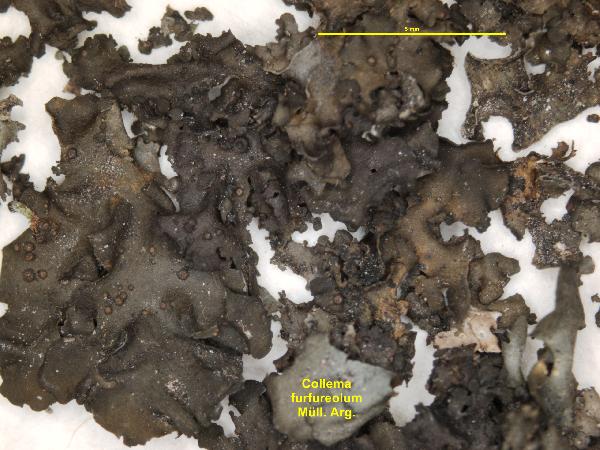Blennothallia furfureola (Müll. Arg.) Otálora, P.M. Jørg. & Wedin
Fungal Divers. (online version), 64: 282, 2013. Basionym: Collema furfureolum Müll. Arg. - Flora, 72: 142, 1889.
Synonyms: Collema sublaeve (Jatta) Zahlbr.
Distribution: S - Pugl, Si.
Description: Thallus foliose, homoiomerous, subgelatinous when wet, often forming 1-3(-4) cm wide, irregular patches, deeply and broadly lobed. Lobes often crowded and imbricate, 0.5-1(-5) mm wide, 65-130(-200) µm thick when wet, rounded, flat or concave, often ascending and ear-shaped, olive-green or greenish black (more green in shaded situations), with at first globular, then flattened isidia-like outgrowths. Lower surface usually paler than upper surface, with white hapters. Upper and lower cortices absent, but middle part of thallus section paraplectenchymatous. Apothecia rather rare, slightly constricted at base, up to 1 mm across, with a brown disc and a thin, finally often excluded, granulose to lobulate thalline margin. Thalline exciple ecorticate; proper exciple thin, subparaplectenchymatous; hymenium colourless, 105-110 µm high, I+ blue; paraphyses simple to sparingly branched, c. 2 µm thick at mid-level, the apical cells up to 5 µm wide; hypothecium colourless to pale yellow. Asci (6-)8-spored, cylindrical-clavate, the apex strongly thickened, the apical dome K/I+ pale blue, with a downwardly projecting K/I+ deep blue tubular structure. Ascospores submuriform, hyaline, broadly oblong to ellipsoid, with rounded or acute ends, 15-20 x 7-8.5 µm. Pycnidia immersed, paler than thallus. Conidia bacilliform, usually slightly swollen at both ends, 4.3-5 x 1.2-1.5 µm. Photobiont cyanobacterial (Nostoc, the cells in short chains with less than 4 cells). Spot tests: all negative. Chemistry: without lichen substances. Note: this species, related to B. crispa, was described from Asia. All European records derive from Degelius (1986), and - in my opinion - they could prove to refer to B. crispa.
Growth form: Foliose, narrow lobed
Substrata: rocks
Photobiont: cyanobacteria, filamentous (e.g. Nostoc, Scytonema)
Reproductive strategy: mainly sexual
Commonnes-rarity: (info)
Alpine belt: absent
Subalpine belt: absent
Oromediterranean belt: absent
Montane belt: absent
Submediterranean belt: absent
Padanian area: absent
Humid submediterranean belt: extremely rare
Humid mediterranean belt: extremely rare
Dry mediterranean belt: extremely rare

Predictive model

United States National Herbarium - Smithsonian (US:Lichens) - Collector: H. Kashiwadani
Number: 13273 Date: 1976-03-2 Locality: Japan, Honshu, Prov. Ise: Mt Fujiwara-dake, Inabe-gun.
Elevation: 320 meters (1050ft) Habitat: Rock - CC BY-NC 3.0 - Source: Consortium of Lichen Herbaria (2023) http//:lichenportal.org/portal/index.php. Accessed on December 18.
Growth form: Foliose, narrow lobed
Substrata: rocks
Photobiont: cyanobacteria, filamentous (e.g. Nostoc, Scytonema)
Reproductive strategy: mainly sexual
Commonnes-rarity: (info)
Alpine belt: absent
Subalpine belt: absent
Oromediterranean belt: absent
Montane belt: absent
Submediterranean belt: absent
Padanian area: absent
Humid submediterranean belt: extremely rare
Humid mediterranean belt: extremely rare
Dry mediterranean belt: extremely rare

Predictive model

 Index Fungorum
Index Fungorum
 GBIF
GBIF

